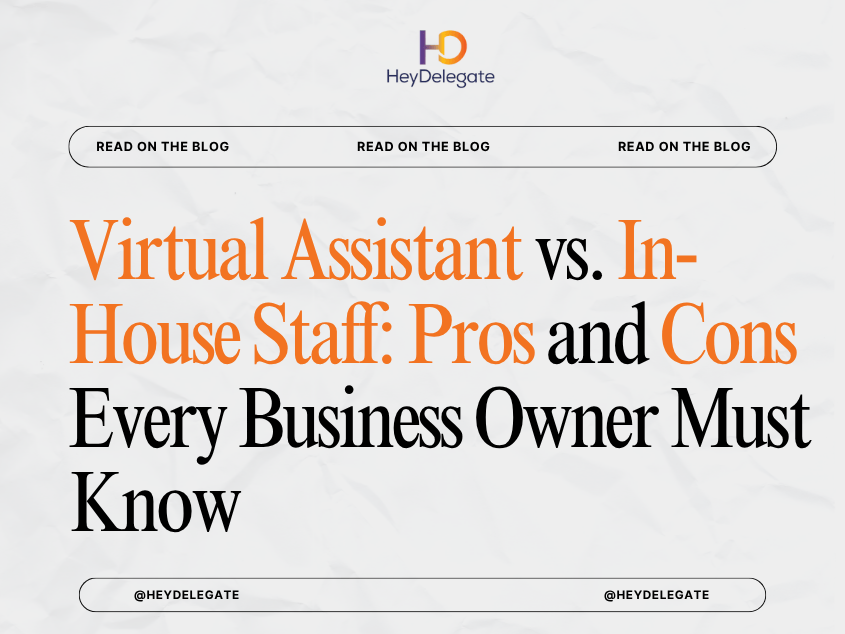As the modern workplace continues to evolve, the question of whether to hire in-house staff or engage virtual assistants (VAs) has become increasingly relevant. For startups, growing businesses, and even established enterprises looking to optimize operations, the decision between virtual and in-house support can impact productivity, culture, budget, and long-term scalability.
Both options offer advantages and limitations, there is no one-size-fits-all solution. The key lies in understanding the nuances of each and matching the right staffing model with your specific business needs.
In this blog, we’ll unpack the pros and cons of hiring virtual assistants vs. in-house employees, explore real-life use cases, and guide you in choosing the ideal structure for your company.
What’s the Difference?
Before we dive into the comparison, let’s define the roles.
- Virtual Assistant (VA): A VA is a remote worker who provides administrative, creative, technical, or operational support. They can be freelancers, contractors, or sourced through agencies and platforms like HeyDelegate, Upwork, or OnlineJobs.ph. VAs typically work part-time or on a project basis and support businesses across borders and time zones.
- In-House Staff: These are full-time or part-time employees who work onsite (or in a hybrid role). They are on your payroll, receive benefits, and are involved in your company’s culture and day-to-day operations. They may specialize in specific roles (e.g., admin, marketing, customer service) and are often more deeply embedded in the organization.
Pros of Hiring a Virtual Assistant
1. Cost Efficiency
One of the most compelling benefits of hiring a VA is affordability. With no need for office space, equipment, insurance, or benefits, VAs significantly reduce overhead costs. You also avoid taxes and payroll complexities if they are freelancers or sourced internationally.
Estimated savings: Businesses can save up to 78% in operating costs annually by hiring virtual staff instead of in-house employees.
2. Flexibility and Scalability
VAs can be hired on-demand, whether for a one-time project, 10 hours a week, or full-time assistance. This flexibility allows businesses to scale up or down without lengthy hiring processes or HR commitments.
3. Access to Global Talent
You are no longer limited to hiring within your city or region. VAs offer access to global expertise, from specialized designers and marketers to bilingual customer support reps, all at competitive rates.
4. Reduced Training Burden
Many VAs are experienced self-starters who don’t need extensive hand-holding. They often come trained in tools like Trello, Canva, Shopify, or HubSpot and can hit the ground running.
5. Increased Productivity
Contrary to popular belief, remote workers often outperform in-house employees due to fewer distractions, greater autonomy, and performance-based contracts. With clear expectations, VAs can be highly efficient.
Cons of Hiring a Virtual Assistant
1. Limited Oversight
Since VAs work remotely, you have less control over their daily environment and workflow. Without the right tools and communication habits, productivity can be difficult to measure or manage.
2. Security and Confidentiality Risks
If not managed properly, remote access to sensitive systems or customer data can present cybersecurity risks. It’s crucial to use contracts, NDAs, and secure tools like password managers.
3. Time Zone Differences
Working with VAs across different time zones can create delays in communication or project handoffs. This can be mitigated by scheduling overlap hours and using asynchronous tools.
4. Less Integration with Company Culture
VAs may not attend team events or be fully involved in the culture and camaraderie of your business. This can impact loyalty, long-term engagement, and internal alignment.
5. Limited Availability or Loyalty
Some VAs work with multiple clients, which can lead to scheduling conflicts or availability issues. They may not always prioritize your tasks unless you have an exclusive agreement.

Pros of Hiring In-House Staff
1. Stronger Team Integration
In-house employees tend to be more immersed in your company culture. They participate in meetings, company events, and daily team interactions, which fosters loyalty and collaboration.
2. Easier Supervision
You can monitor performance, offer real-time feedback, and provide hands-on training. This is especially important for roles that require close coordination or access to physical infrastructure.
3. Long-Term Commitment
Employees are more likely to build a long-term relationship with your business, especially if offered a clear career path. This helps with knowledge retention and institutional growth.
4. Clearer Accountability
With formal contracts, clear job descriptions, and set working hours, employees are easier to manage in terms of accountability, performance reviews, and HR processes.
5. Better Collaboration for Complex Tasks
For projects requiring high collaboration, in-house teams can brainstorm, meet, and resolve challenges faster through real-time interaction, reducing back-and-forth delays.
Cons of Hiring In-House Staff
1. Higher Costs
Employees come with payroll taxes, insurance, health benefits, office equipment, paid leave, and more. For many small businesses, this overhead is difficult to sustain long-term.
2. Less Flexibility
Employees are usually hired for fixed hours and roles, even when their workload fluctuates. This leads to periods of underutilization or overwork.
3. Longer Hiring and Onboarding Process
Finding, vetting, and training in-house staff can take weeks or months. It also requires internal HR processes, onboarding systems, and ongoing support.
4. Office Space and Resources Required
Unless fully remote, in-house staff need desks, computers, internet, and office supplies. The cost and logistics of maintaining physical space can add up quickly.
5. Risk of Turnover
If an employee quits suddenly, the cost of replacing them, both in time and money, can be substantial, especially in small teams.

Side-by-Side Comparison Table
| Criteria | Virtual Assistant (VA) | In-House Staff |
| Cost | Low (no benefits or overhead) | High (salaries, benefits, taxes) |
| Flexibility | High (on-demand, scalable) | Low (fixed hours/contracts) |
| Hiring Time | Fast (often within days) | Slow (weeks to months) |
| Supervision | Limited | High |
| Cultural Fit | Moderate to Low | High |
| Access to Global Talent | Yes | Limited by location |
| Training Required | Often minimal | Varies, often more intensive |
| Security Management | Needs robust remote systems | More controlled in office |
| Best for | Admin, content, tech support, design | Core team, leadership, operations |
When to Choose a Virtual Assistant
Consider hiring a VA if:
- You’re a startup or solopreneur looking to cut costs
- You have fluctuating workloads
- You need specialized support (e.g., email marketing, data entry, order fulfillment)
- You want to scale without the risk of long-term employment contracts
- You’re experimenting with new roles and responsibilities
- Your team is remote-first and accustomed to asynchronous work
When to Choose In-House Staff
Choose in-house employees if:
- You need someone physically present (retail, operations, etc.)
- The role requires close collaboration with leadership
- You’re building a long-term leadership pipeline
- Company culture, loyalty, and cohesion are top priorities
- The role is complex or involves sensitive information that requires physical oversight
Hybrid Models: The Best of Both Worlds
Many growing businesses are now adopting a hybrid model, building a core team of in-house staff while delegating non-core or specialized tasks to virtual assistants. For example:
- In-house staff handles strategic planning, sales, and leadership.
- Virtual assistants manage customer support, calendar management, email marketing, bookkeeping, low-code automation or content writing.
This model allows companies to remain agile, cost-efficient, and scalable without compromising on internal culture and leadership.
Case Study: Blending VA and In-House Teams for Growth
Company: A boutique marketing agency in the U.S.
Challenge: Limited budget but growing client demands
Solution:
- Hired a part-time in-house project manager
- Delegated graphic design and admin tasks to two offshore VAs
- Used Slack, ClickUp, and Zoom to coordinate the hybrid team
Results:
- Reduced operating costs by 40%
- Tripled client capacity within 6 months
- Built a system for scaling without hiring a full office staff
Which Is Right for You?
There’s no definitive winner in the “Virtual Assistant vs. In-House Staff” debate. The right choice depends on your current goals, available resources, company structure, and long-term vision.
For lean startups and digital-first companies, virtual assistants offer unmatched flexibility and cost savings. For businesses prioritizing tight collaboration and deep cultural alignment, in-house employees are invaluable.
And for many modern companies? A hybrid approach offers the perfect balance.
Looking to Build a Smarter Support System?
Whether you’re ready to delegate your first task or scale your entire back office, virtual assistants offer a powerful way to grow without growing overhead. Let HeyDelegate help you build your ideal support team, virtual, in-house, or hybrid.




1 thought on “Virtual Assistant vs. In-House Staff: Pros and Cons Every Business Owner Must Know”
I’d like to thank you for the efforts you have put
in writing this blog. I’m hoping to see the same high-grade blog posts from you later on as
well. In truth, your creative writing abilities has inspired me to get my own site now
😉